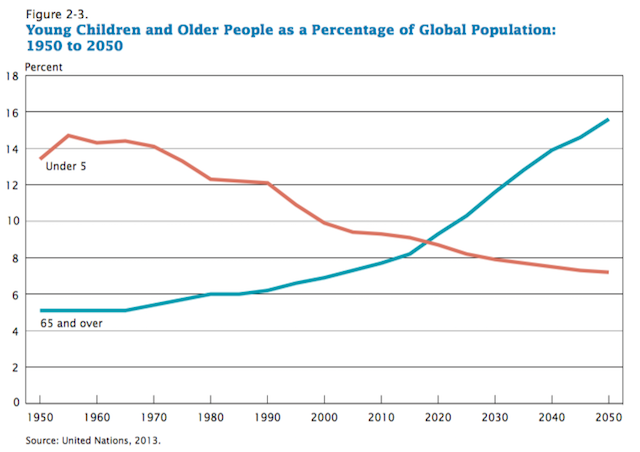Highlights
Within the next four years, humanity will reach a new milestone, the Census Bureau reports: “For the first time in human history, people aged 65 and over will outnumber children under age 5.” And over the following thirty years, the elderly will vastly increase their numerical advantage to make up 15.6 percent of the population by 2050, vs. 7.2 percent for kids under five.
That’s just one of many ways to slice the data on the ongoing aging of the global population, a trend extensively documented in the new Census publication An Aging World: 2015.

Older people represent a widely varying proportion of national populations today, from around 1 percent in Qatar and United Arab Emirates, 6.0 percent in India, and 10.1 percent in China to 26.6 percent in Japan. In the United States the figure stands at 14.9 percent, making us the world’s 48th-oldest country.
The question of how to support our growing elderly population should doubtless receive more attention than it has in this election cycle, but many countries will confront an even greater challenge than we do. While Americans ages 65 and up will account for a projected 22.1 percent of the population by 2050, at that point we’ll be just the 85th-oldest nation because so many other countries’ populations will age even faster.
Indeed, while it took France 115 years and the U.S. 69 years for the older population to double from 7 percent of the population to 14 percent, Chile is on pace to do the same in 26 years, and China in just 23. The lower per-capita GDPs of the latter pair of countries will make their rapid aging even more difficult. As a World Health Organization official memorably pointed out in 2002, “while the developed countries became rich before they became old, the developing nations will become old before they become rich.”
Relatedly, and needless to say, not all people ages 65 and up experience the kind of leisurely retirement that most Americans hope to enjoy. As of 2010, less than 10 percent of older Europeans and less than 20 percent of North Americans participated in the labor force, compared to more than 50 percent of older men and more than 30 percent of older women in Africa. Richer countries are generally home to lower rates of labor force participation among the old, though these rates have risen in most developed countries since the 1990s.
Every region of the world will experience population aging to some degree in this century, but Africa will undergo the change more slowly than other regions, thanks to its high total fertility rate, which is now 4.4. That’s not to say Africa faces an easy path ahead—only that their struggle to feed, shelter, and keep healthy a vulnerable sector of the population will continue to center on the young rather than the old.
On a more optimistic note, although the coming changes in the global population are unprecedented, so too are the wealth and technology in our possession today. With creativity, compromise, and a willingness to make some sacrifices, navigating the path ahead may prove easier than we fear.













